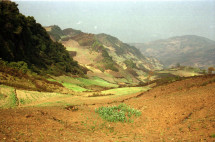HIV/AIDS and Drug Use in Burma/Myanmar
Topics
The increasing number of injecting drug users (IDUs) and the growing HIV/AIDS epidemic in Burma presents one of the most serious health threats to the population in the country, and also to the region at large. Infection rates among IDUs in Burma are among the highest in the world. The international community needs to make a firm commitment to stem the HIV/AIDS epidemic in Burma and should ensure sufficient and long-term financial support for HIV/AIDS and harm reduction programmes.

The increasing number of injecting drug users (IDUs) and the growing HIV/AIDS epi-demic in Burma presents one of the most serious health threats to the population in the country, and also to the region at large. Infection rates among IDUs in Burma are among the highest in the world.
UNAIDS has warned that Burma is close to the tipping point, where the critical mass of infection becomes so great that the epidemic is self-sustaining in the general population, even in the event of a significant reduction in risk behaviour in the most vulner-able sub-populations, such as IDUs.
Yet while the need for an adequate and im-mediate response to the public health crisis in Burma is clear, a number of factors have limited the scope and effectiveness of humanitarian assistance in the country, which has strong socio-economic impacts on peo-ple's lives.
The military government, the State Peace and Development Council (SPDC), has imposed several new restrictions on the operations of UN agencies and international NGOs in the country. Furthermore, a number of international donors oppose giving humanitarian aid to Burma, mainly for political reasons. A major blow to efforts to avert the HIV/AIDS epidemic was the decision of the Global Fund to terminate its grants agreements to Burma.
Recommendations
-
- All stakeholders involved should acknowledge the HIV/AIDS epidemic and the need for harm reduction policies. It is key for all sides to depoliticise HIV/AIDS.
-
- The international community needs to make a firm commitment to stem the HIV/AIDS epidemic in Burma and should ensure sufficient and long-term financial support for HIV/AIDS and harm reduction programmes.
-
- The government of Burma/Myanmar should provide adequate conditions for humanitarian aid to take place and ensure unhindered access for international aid agencies to local communities. The space for initial harm reduction initiatives is encouraging but needs to be scaled up in order to be effective.
-
- Local community-based organisations in Burma should be able to participate in the debate about international humanitarian aid to Burma. In particular, people living with HIV/AIDS, and drug users or organisations that represent them, should be consulted in discussions and decision-making processes about the funding for programmes on HIV/AIDS.
Pages: 17